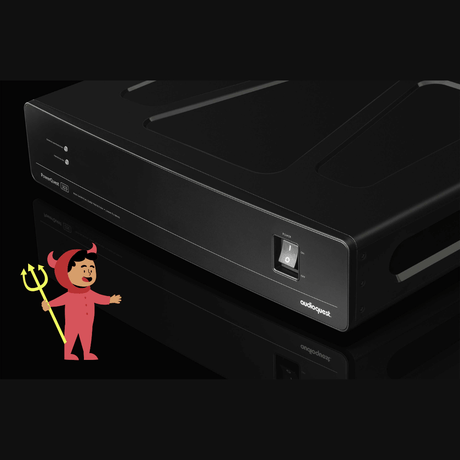
Scientist Says PowerQuest 303 is "Evil!"
Jürgen Krauss, founder of AudioReviews.org, is a scientist. What does he make of high-performance power conditioning? PURE EVIL.
Kabel audio wysokiej rozdzielczości
Często wybór pomiędzy zakończeniem kabli głośnikowych za pomocą widełek spadowych a wtykami bananowymi sprowadza się do osobistych preferencji. Jednak zgodne z normami UE izolowane zaciski stosowane w niektórych wzmacniaczach mocy często utrudniają, jeśli nie uniemożliwiają, dokręcenie widełek spadowych z dużym momentem obrotowym lub naciskiem. W takich przypadkach złącze bananowe AudioQuest jest lepszym wyborem, a może być jedynym wyborem.
AudioQuest przeprowadziło dość szerokie badanie współczesnych producentów wzmacniaczy, aby określić, czy widełki czy banany będą najbardziej odpowiednie dla danej marki i modelu wzmacniacza. Prosimy skontaktuj się z nami, podaj markę i model wzmacniacza, a my odpowiemy z optymalnym typem złącza.
W tym przypadku zazwyczaj zalecamy złącze U-Spade lub bananowe. Jednak mimo że po tej stronie kabla jest mniej wagi i nacisku (szczególnie w przypadku zestawów BiWire), ważne jest, aby zwrócić uwagę na konstrukcję zacisku. Jeśli złącze bananowe nie może być w pełni osadzone w zacisku, zalecamy jedno z naszych złączy spadowych.
Solidne przewodniki srebrne 10%
Solidne przewodniki minimalizują szkodliwe efekty zarówno elektrycznego, jak i magnetycznego oddziaływania między włóknami. Dla kabli cyfrowych, których sygnały mają tak wysoką częstotliwość, że przemieszczają się niemal wyłącznie na powierzchni przewodnika, stosuje się coraz grubsze warstwy srebrnej powłoki na przewodnikach z miedzi o długich ziarnach (LGC) AudioQuest, aby dodatkowo poprawić tłumienie szumów. Umieszczenie lepszego metalu na zewnątrz przewodnika przynosi największe korzyści dla ogólnej wydajności - niezwykle opłacalny sposób na maksymalizację kabla cyfrowego.
3-warstwowe tłumienie szumów oparte na Carbon
Łatwo jest osiągnąć 100% pokrycie ekranu. Zapobieganie modulacji odniesienia uziemienia sprzętu przez wychwycone zakłócenia radiowe (RFI) wymaga zastosowania Noise-Dissipation System AQ (NDS). Tradycyjne systemy ekranowania zazwyczaj absorbują, a następnie odprowadzają energię szumów/RF do uziemienia komponentów, modulując i zniekształcając krytyczną płaszczyznę odniesienia, co z kolei powoduje zniekształcenie sygnału. Naprzemienne warstwy metalu i syntetyków obciążonych carbon w NDS „ekranują ekran”, absorbując i odbijając większość tej energii szumów/RF, zanim dotrze ona do warstwy przymocowanej do ziemi.
System polaryzacji dielektrycznej 72v (DBS)
Wszystkie izolacje między dwoma lub więcej przewodnikami są również dielektrykami, których właściwości wpływają na integralność sygnału. Kiedy dielektryk jest niepolaryzowany, udział dielektryczny (absorpcja i nieliniowe uwalnianie energii) powoduje różne opóźnienia czasowe (przesunięcie fazowe) dla różnych częstotliwości i poziomów energii, co jest realnym problemem dla bardzo czułej na czas muzyki wielooktawowej. Włączenie pułapki RF (opracowanej dla serii produktów zasilających AudioQuest Niagara) zapewnia, że szum radiowy nie zostanie wprowadzony do przewodników sygnałowych z elementów pola DBS. (DBS, US Pat #s 7,126,055 & 7,872,195 B1)
Izolacja z pianki o twardych komórkach
Izolacja z pianki o twardych komórkach (HCF) zapewnia krytyczną geometrię pary sygnałowej. Każdy stały materiał przylegający do przewodnika jest w rzeczywistości częścią niedoskonałego obwodu. Izolacja przewodów i materiały płytki drukowanej pochłaniają energię. Część tej energii jest magazynowana, a następnie uwalniana jako zniekształcenie. Izolacja z pianki o twardych komórkach jest podobna do pianki PE stosowanej w naszych bardziej przystępnych cenowo kablach Bridges & Falls i jest wtryskiwana azotem, aby tworzyć kieszenie powietrzne. Ponieważ azot (podobnie jak powietrze) nie pochłania energii, a zatem nie uwalnia żadnej energii z przewodnika ani do niego, zniekształcenia są zredukowane. Ponadto sztywność materiału pozwala przewodnikom kabla utrzymać stabilną relację na całej długości kabla, co zapewnia stabilny charakter impedancji i dodatkowo minimalizuje zniekształcenia.
Przewodniki o kontrolowanym kierunku
Wszystkie ciągnięte metalowe przewody lub przewodniki mają niesymetryczną, a zatem kierunkową strukturę ziarnistą. AudioQuest kontroluje wynikową zmienność impedancji RF, aby hałas był odprowadzany z miejsca, w którym mógłby powodować zniekształcenia. Prawidłowy kierunek określa się, słuchając każdej partii metalowych przewodników używanych w każdym kablu audio AudioQuest. W razie potrzeby, strzałki są wyraźnie zaznaczone na złączach, aby zapewnić doskonałą jakość dźwięku. Dla większości modeli kabli AQ, strzałki nie tylko wskazują kierunek, który optymalizuje kierunkowość metalu jako część tłumienia hałasu, ale także wskazują niesymetryczne połączenie osłony i GND w celu optymalizacji wydajności całego systemu. Podstawowy aspekt wieloaspektowej technologii tłumienia hałasu AudioQuest, przewodniki kierunkowe zapewniają, że indukowany hałas jest prawidłowo rozpraszany i odprowadzany.